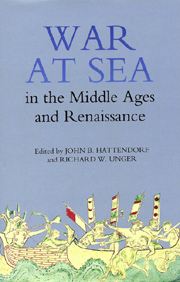Book contents
- Frontmatter
- Contents
- List of illustrations
- List of Contributors
- Preface
- Acknowledgements
- Introduction: Theories of Naval Power: A. T. Mahan and the Naval History of Medieval and Renaissance Europe
- I Northern Europe
- II Southern Europe
- III Sixteenth and Early-Seventeenth-Century Europe
- The Navies of the Medici: The Florentine Navy and the Navy of the Sacred Military Order of St Stephen, 1547–1648
- The State of Portuguese Naval Forces in the Sixteenth Century
- Naval Power in the Netherlands before the Dutch Revolt
- Naval Power and Control of the Sea in the Baltic in the Sixteenth Century
- The New Atlantic: Naval Warfare in the Sixteenth Century
- Conclusion: Toward a History of Medieval Sea Power
- Index
- Titles in the series
Naval Power in the Netherlands before the Dutch Revolt
from III - Sixteenth and Early-Seventeenth-Century Europe
Published online by Cambridge University Press: 05 April 2013
- Frontmatter
- Contents
- List of illustrations
- List of Contributors
- Preface
- Acknowledgements
- Introduction: Theories of Naval Power: A. T. Mahan and the Naval History of Medieval and Renaissance Europe
- I Northern Europe
- II Southern Europe
- III Sixteenth and Early-Seventeenth-Century Europe
- The Navies of the Medici: The Florentine Navy and the Navy of the Sacred Military Order of St Stephen, 1547–1648
- The State of Portuguese Naval Forces in the Sixteenth Century
- Naval Power in the Netherlands before the Dutch Revolt
- Naval Power and Control of the Sea in the Baltic in the Sixteenth Century
- The New Atlantic: Naval Warfare in the Sixteenth Century
- Conclusion: Toward a History of Medieval Sea Power
- Index
- Titles in the series
Summary
IN historical studies, the term ‘sea power’ – meaning control over the sea – is usually connected with the work of the American naval officer A. T. Mahan. He established the principle that the sea could only be brought under control through the domination of the enemy's naval forces. According to Mahan this could only be realised in sea battles, and, if necessary, by blockades combined with the threat of an attack. The greatest care should to be exercised with regard to Mahan's concepts of sea power in the period preceding the one on which he based his conclusions. The danger has not discouraged historians from finding inspiration in his ideas on sea power.
The present paper seeks to contribute to the debate about the relevance of Mahan's concept of sea power for the early modern period by studying the case of the Habsburg Netherlands. Although the Netherlands were not engaged in any major sea battle during the first half of the sixteenth century a certain notion of sea power does seem to have played a role in naval strategic thinking. It will be argued that naval superiority alone over enemy forces did not ensure the exercise of sea power. After all, merchant ships played an important role in naval warfare well into the seventeenth century. Therefore the total seagoing merchant fleet of a town, region or country – the maritime potential – had to be taken into account when considering its sea power.
- Type
- Chapter
- Information
- War at Sea in the Middle Ages and the Renaissance , pp. 199 - 216Publisher: Boydell & BrewerPrint publication year: 2002

